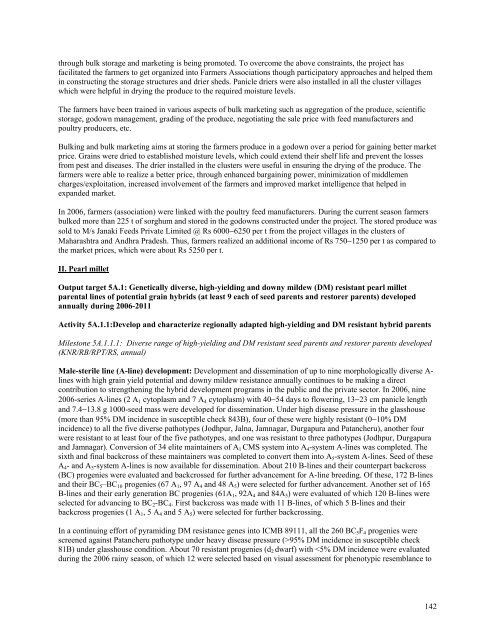ICRISAT Archival Report 2006 - The seedlings of success in the ...
ICRISAT Archival Report 2006 - The seedlings of success in the ...
ICRISAT Archival Report 2006 - The seedlings of success in the ...
You also want an ePaper? Increase the reach of your titles
YUMPU automatically turns print PDFs into web optimized ePapers that Google loves.
through bulk storage and market<strong>in</strong>g is be<strong>in</strong>g promoted. To overcome <strong>the</strong> above constra<strong>in</strong>ts, <strong>the</strong> project has<br />
facilitated <strong>the</strong> farmers to get organized <strong>in</strong>to Farmers Associations though participatory approaches and helped <strong>the</strong>m<br />
<strong>in</strong> construct<strong>in</strong>g <strong>the</strong> storage structures and drier sheds. Panicle driers were also <strong>in</strong>stalled <strong>in</strong> all <strong>the</strong> cluster villages<br />
which were helpful <strong>in</strong> dry<strong>in</strong>g <strong>the</strong> produce to <strong>the</strong> required moisture levels.<br />
<strong>The</strong> farmers have been tra<strong>in</strong>ed <strong>in</strong> various aspects <strong>of</strong> bulk market<strong>in</strong>g such as aggregation <strong>of</strong> <strong>the</strong> produce, scientific<br />
storage, godown management, grad<strong>in</strong>g <strong>of</strong> <strong>the</strong> produce, negotiat<strong>in</strong>g <strong>the</strong> sale price with feed manufacturers and<br />
poultry producers, etc.<br />
Bulk<strong>in</strong>g and bulk market<strong>in</strong>g aims at stor<strong>in</strong>g <strong>the</strong> farmers produce <strong>in</strong> a godown over a period for ga<strong>in</strong><strong>in</strong>g better market<br />
price. Gra<strong>in</strong>s were dried to established moisture levels, which could extend <strong>the</strong>ir shelf life and prevent <strong>the</strong> losses<br />
from pest and diseases. <strong>The</strong> drier <strong>in</strong>stalled <strong>in</strong> <strong>the</strong> clusters were useful <strong>in</strong> ensur<strong>in</strong>g <strong>the</strong> dry<strong>in</strong>g <strong>of</strong> <strong>the</strong> produce. <strong>The</strong><br />
farmers were able to realize a better price, through enhanced barga<strong>in</strong><strong>in</strong>g power, m<strong>in</strong>imization <strong>of</strong> middlemen<br />
charges/exploitation, <strong>in</strong>creased <strong>in</strong>volvement <strong>of</strong> <strong>the</strong> farmers and improved market <strong>in</strong>telligence that helped <strong>in</strong><br />
expanded market.<br />
In <strong>2006</strong>, farmers (association) were l<strong>in</strong>ked with <strong>the</strong> poultry feed manufacturers. Dur<strong>in</strong>g <strong>the</strong> current season farmers<br />
bulked more than 225 t <strong>of</strong> sorghum and stored <strong>in</strong> <strong>the</strong> godowns constructed under <strong>the</strong> project. <strong>The</strong> stored produce was<br />
sold to M/s Janaki Feeds Private Limited @ Rs 6000−6250 per t from <strong>the</strong> project villages <strong>in</strong> <strong>the</strong> clusters <strong>of</strong><br />
Maharashtra and Andhra Pradesh. Thus, farmers realized an additional <strong>in</strong>come <strong>of</strong> Rs 750−1250 per t as compared to<br />
<strong>the</strong> market prices, which were about Rs 5250 per t.<br />
II. Pearl millet<br />
Output target 5A.1: Genetically diverse, high-yield<strong>in</strong>g and downy mildew (DM) resistant pearl millet<br />
parental l<strong>in</strong>es <strong>of</strong> potential gra<strong>in</strong> hybrids (at least 9 each <strong>of</strong> seed parents and restorer parents) developed<br />
annually dur<strong>in</strong>g <strong>2006</strong>-2011<br />
Activity 5A.1.1:Develop and characterize regionally adapted high-yield<strong>in</strong>g and DM resistant hybrid parents<br />
Milestone 5A.1.1.1: Diverse range <strong>of</strong> high-yield<strong>in</strong>g and DM resistant seed parents and restorer parents developed<br />
(KNR/RB/RPT/RS, annual)<br />
Male-sterile l<strong>in</strong>e (A-l<strong>in</strong>e) development: Development and dissem<strong>in</strong>ation <strong>of</strong> up to n<strong>in</strong>e morphologically diverse A-<br />
l<strong>in</strong>es with high gra<strong>in</strong> yield potential and downy mildew resistance annually cont<strong>in</strong>ues to be mak<strong>in</strong>g a direct<br />
contribution to streng<strong>the</strong>n<strong>in</strong>g <strong>the</strong> hybrid development programs <strong>in</strong> <strong>the</strong> public and <strong>the</strong> private sector. In <strong>2006</strong>, n<strong>in</strong>e<br />
<strong>2006</strong>-series A-l<strong>in</strong>es (2 A 1 cytoplasm and 7 A 4 cytoplasm) with 40−54 days to flower<strong>in</strong>g, 13−23 cm panicle length<br />
and 7.4−13.8 g 1000-seed mass were developed for dissem<strong>in</strong>ation. Under high disease pressure <strong>in</strong> <strong>the</strong> glasshouse<br />
(more than 95% DM <strong>in</strong>cidence <strong>in</strong> susceptible check 843B), four <strong>of</strong> <strong>the</strong>se were highly resistant (0−10% DM<br />
<strong>in</strong>cidence) to all <strong>the</strong> five diverse pathotypes (Jodhpur, Jalna, Jamnagar, Durgapura and Patancheru), ano<strong>the</strong>r four<br />
were resistant to at least four <strong>of</strong> <strong>the</strong> five pathotypes, and one was resistant to three pathotypes (Jodhpur, Durgapura<br />
and Jamnagar). Conversion <strong>of</strong> 34 elite ma<strong>in</strong>ta<strong>in</strong>ers <strong>of</strong> A 1 CMS system <strong>in</strong>to A 4 -system A-l<strong>in</strong>es was completed. <strong>The</strong><br />
sixth and f<strong>in</strong>al backcross <strong>of</strong> <strong>the</strong>se ma<strong>in</strong>ta<strong>in</strong>ers was completed to convert <strong>the</strong>m <strong>in</strong>to A 5 -system A-l<strong>in</strong>es. Seed <strong>of</strong> <strong>the</strong>se<br />
A 4 - and A 5 -system A-l<strong>in</strong>es is now available for dissem<strong>in</strong>ation. About 210 B-l<strong>in</strong>es and <strong>the</strong>ir counterpart backcross<br />
(BC) progenies were evaluated and backcrossed for fur<strong>the</strong>r advancement for A-l<strong>in</strong>e breed<strong>in</strong>g. Of <strong>the</strong>se, 172 B-l<strong>in</strong>es<br />
and <strong>the</strong>ir BC 5 –BC 10 progenies (67 A 1 , 97 A 4 and 48 A 5 ) were selected for fur<strong>the</strong>r advancement. Ano<strong>the</strong>r set <strong>of</strong> 165<br />
B-l<strong>in</strong>es and <strong>the</strong>ir early generation BC progenies (61A 1 , 92A 4 and 84A 5 ) were evaluated <strong>of</strong> which 120 B-l<strong>in</strong>es were<br />
selected for advanc<strong>in</strong>g to BC 2 -BC 4 . First backcross was made with 11 B-l<strong>in</strong>es, <strong>of</strong> which 5 B-l<strong>in</strong>es and <strong>the</strong>ir<br />
backcross progenies (1 A 1 , 5 A 4 and 5 A 5 ) were selected for fur<strong>the</strong>r backcross<strong>in</strong>g.<br />
In a cont<strong>in</strong>u<strong>in</strong>g effort <strong>of</strong> pyramid<strong>in</strong>g DM resistance genes <strong>in</strong>to ICMB 89111, all <strong>the</strong> 260 BC 5 F 4 progenies were<br />
screened aga<strong>in</strong>st Patancheru pathotype under heavy disease pressure (>95% DM <strong>in</strong>cidence <strong>in</strong> susceptible check<br />
81B) under glasshouse condition. About 70 resistant progenies (d 2 dwarf) with

















